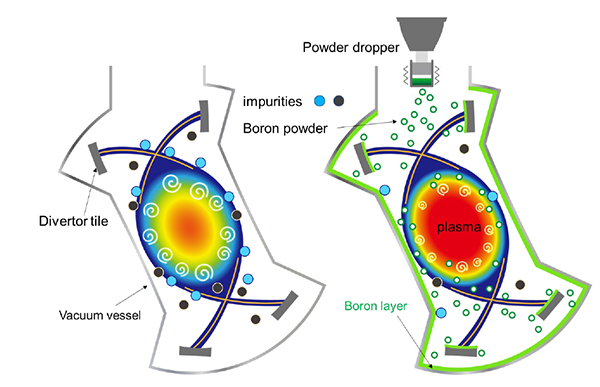Boron powder injection makes plasma temperature increase Both impurities and turbulence are suppressed simultaneously in a discharge
2022.1.17 Research Results (Press Release)Abstract
In order to realize fusion power generation, it is necessary to maintain a high-temperature plasma. For this maintenance, impurities generated from the vessel walls and turbulence generated in the plasma which can cause it large energy loss should be suppressed. An international collaboration research team consisting of Doctor Federico Nespoli at the Princeton Plasma Physics Laboratory, Professor Suguru Masuzaki at the National Institute for Fusion Science and their colleagues, performed the experiment of injecting tiny grains of boron powder into plasma in the Large Helical Device (LHD). They found that the boron powder injection can reduce both impurities from the wall and turbulence in the plasma. This result will greatly contribute to the establishment of a method to stably maintain a high-temperature plasma.
Research Background
In order to realize fusion power generation, it is necessary to confine the deuterium-tritium mixture plasma by using a strong magnetic field, heat it to a temperature of over 100 million degrees Celsius, and maintain it stably. However, when impurities such as oxygen generated from the vessel wall enter the plasma, its temperature decreases due to heat loss. In addition, turbulence, which is a flow with vortices of various sizes, is generated in a high-temperature plasma, and this turbulence can cause plasma heat loss by enhancing particle and energy transport. To maintain a high-temperature plasma, we must establish a method to suppress such heat losses. If both the impurities and the turbulence can be suppressed simultaneously by the same method, It would be a very promising way to maintain a high temperature plasma.
One way to reduce the heat loss due to impurities from the walls is to coat the walls with boron. At the Large Helical Device (LHD) of the National Institute for Fusion Science (NIFS), the walls are coated with boron before the start of each year's experimental campaign. However, once the experiment begins, it is difficult to make a new boron coating on the walls because the usual one is conducted in a glow discharge without a magnetic field.
Research Result
In an international collaboration with the Princeton Plasma Physics Laboratory (PPPL) in the United States, NIFS has installed a device in the LHD for injecting controlled amounts of submillimeter powder grains into the plasma under the action of gravity. The installation of this device has made it possible to make a new boron coating on the walls in real time by injecting boron powder into the plasma, while conducting LHD plasma experiments. As a result, it was observed that the impurities from the wall were reduced and the plasma temperature increased.
Furthermore, the international collaboration research team of Doctor Federico Nespoli at PPPL, Professor Suguru Masuzaki at NIFS and their colleagues, found that while injecting boron powder into the plasma, its heat loss was suppressed and plasma temperature became higher than that before the injection, and the good state was stably sustained during the injection. This could not be explained only by the reduction of impurities from the walls.
In order to clarify the reason why such a good state can be maintained stably, the research team measured the plasma state in detail, using an advanced measurement technique. They then analyzed the newly obtained measurement data and the numerous accumulated data that had been obtained by experiments and computer simulations. As a result, it was found that the injection of boron powder suppressed turbulence generated in the plasma. In other words, the research team has found that by injecting boron powder into the plasma, we can simultaneously suppress both impurities from the walls and turbulence in the plasma and can suppress heat losses from the plasma.
Significance of results
The research team has shown a way to suppress impurities from the wall and turbulence in the plasma in real time. In a future fusion reactor, it will be necessary to suppress plasma temperature decrease during operation. The result of this study will make a significant contribution to the establishment of such a method.

Figure caption:Cross-sectional view of the LHD. The blue and gray ● represent impurities generated from the vacuum vessel wall, and the white vortex represents turbulence in the plasma. (left)No boron powder. Many impurities from the wall and large turbulence in the plasma. (right)With boron powder injection. Green circles are boron. The walls are coated with boron (green colored layer), reducing impurities from the walls. In addition, the turbulence in the plasma is suppressed. As a result, the heat loss from the plasma becomes smaller, and the plasma temperature higher.
Paper information
Journal name: Nature Physics
Title:Observation of a reduced-turbulence regime with boron powder injection in a stellarator
Author(s): Federico Nespoli1, Takashi Masuzaki2,3, Kenji Tanaka2,4, Naoko Ashikawa2,3, Mamoru Shoji2, Eric Gilson1, Robert Lunsford1, et al.
1 Princeton Plasma Physics Laboratory, 2 National Institute for Fusion Science, National Institutes of Natural Sciences
3 The Graduate University for Advanced Studies
5 Department of Plasma and Quantum Science and Engineering, Graduate School of Science and Technology, Kyushu University
Research Support
(1) This research was conducted based on the following research cooperation agreement.
- Agreement on Academic Exchange between the National Institute for Fusion Science and the Princeton Plasma Physics Laboratory
(NIFS/PPPL International Collaboration) - Agreement between the U.S. Department of Energy and Princeton University
(U.S. DOE under Contract No. DE-AC02-09CH11466 with Princeton University.)
For inquiries regarding this matter, please contact
National Institutes of Natural Sciences, National Institute for Fusion Science, Helical Research Division
- Fusion Systems Research Division
Professor Suguru Masuzaki
Phone: 0572-58-2168
